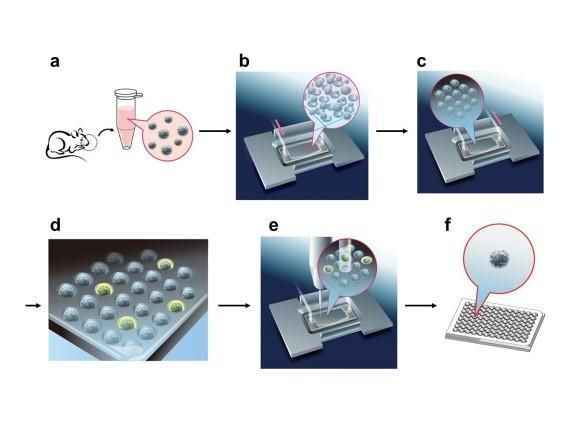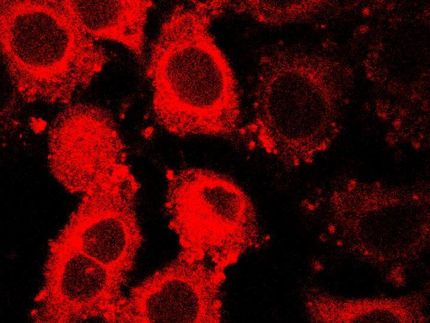New method for exhaustively isolating olfactory receptors responding to specific odorants
A research group led by Osaka University and Panasonic Corporation developed a method for making a prompt, exhaustive isolation of olfactory receptors (ORs) responding to the odorant of interest. This achievement will enable quick and easy exhaustive analysis of ORs responding to specific odorants, which previously required a great deal of time and effort. These results may be applied to biosensors capable of highly detecting only desired odorants.

Mouse olfactory epithelium-derived cells were labeled with Fluo4-AM (a), and applied to a 10-μm microchamber array chip equipped with a flow chamber, followed by brief centrifugation (b). Floating and untrapped cells were removed by circulating Ringer solution and stimulated with an odorant (c). OSNs expressing odorant-specific ORs showed transient fluorescence from the increase of intracellular Ca2+ concentration (d). Each activated cell was retrieved (e), transferred to the 96-well PCR plate (f), and subjected to single-cell RT-PCR.
Osaka University
Paying attention to the fact that each olfactory sensory neuron (OSN) expresses an OR, Shun'ichi Kuroda, Professor and Nobuo Yoshimoto, Specially Appointed Associate Professor at the Department of Biomolecular Science and Reaction, The Institute of Scientific and Industrial Research, Osaka University in cooperation with Masato Suzuki, Chief Researcher, Advanced Research Division, Panasonic Corporation made a system in which OSNs from mice were applied to a microchamber array on a microscope slide and fluorescence was yielded when ORs responded to odorants. Using the Single-Cell Automatic Analysis and Isolation System developed in 2013, this group isolated single OSNs responding to specific odorants in a time-lapse single-cell-array cytometric manner and identified the OR gene through single cell polymerase chain reaction (PCR).
As a result, this group succeeded in isolating ORs which respond to three types of volatile organic compounds (2-pentanone, pyridine, 2-butanone) respectively in urine samples from lung cancer patients. Like OSNs, animal cells expressing ORs responded to the odorant of interest, emitting fluorescence.
Original publication
Other news from the department science
These products might interest you

Octet R2 / Octet R4 / Octet R8 by Sartorius
Full power on 2, 4 or 8 channels: Label-free and GxP-compliant analysis of molecular interactions
Innovative label-free real-time protein quantification, binding kinetics and rapid screenings

Octet RH16 and RH96 by Sartorius
Efficient protein analysis for process optimisation and manufacturing control in high-throughput
Label-free protein quantification and characterization of protein-protein interactions

Octet SF3 by Sartorius
Surface Plasmon Resonance (SPR) using Single Dynamic Injections for Kinetics and Affinities
Curvature is Key - Adding a ‘Third Dimension’ to the Binding Curve

Get the life science industry in your inbox
By submitting this form you agree that LUMITOS AG will send you the newsletter(s) selected above by email. Your data will not be passed on to third parties. Your data will be stored and processed in accordance with our data protection regulations. LUMITOS may contact you by email for the purpose of advertising or market and opinion surveys. You can revoke your consent at any time without giving reasons to LUMITOS AG, Ernst-Augustin-Str. 2, 12489 Berlin, Germany or by e-mail at revoke@lumitos.com with effect for the future. In addition, each email contains a link to unsubscribe from the corresponding newsletter.




















































